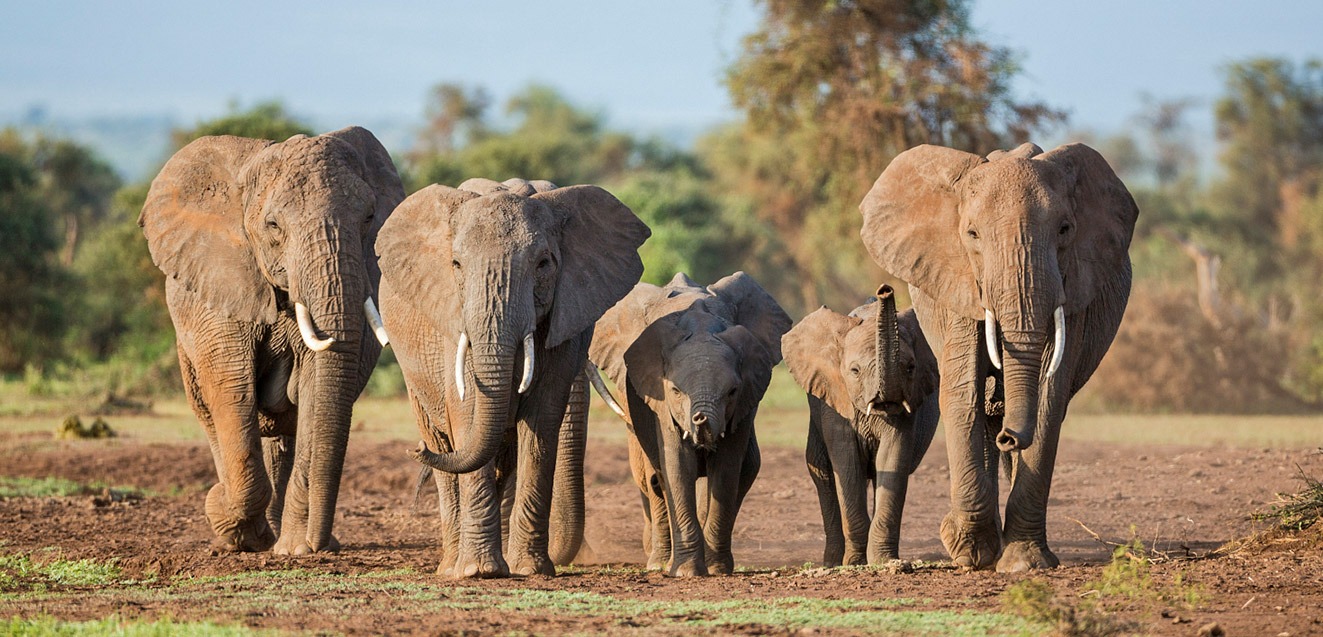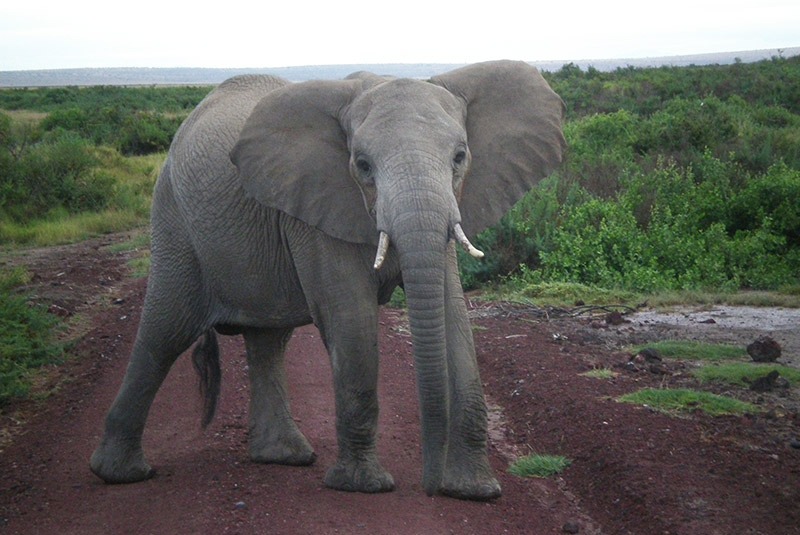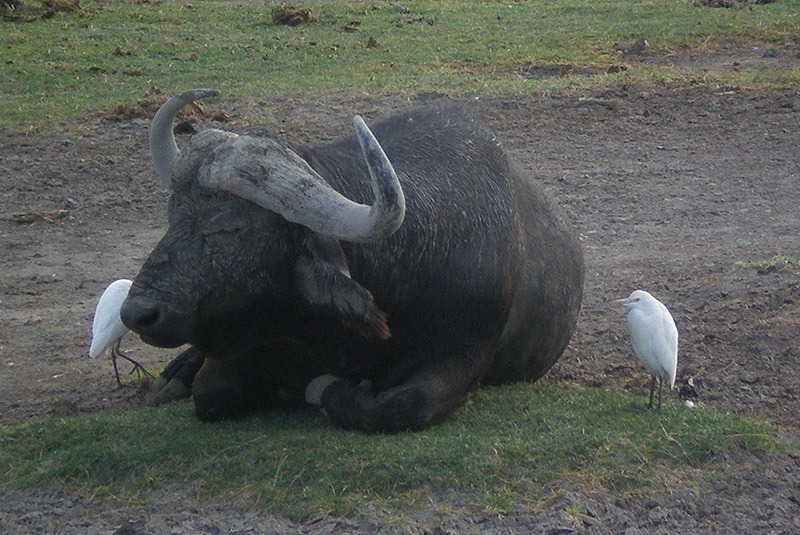Kenya Safari: Part Three – Under the Elephant’s Spell

Following my recent conversation with Emily Barth and Matt Kukta about their unexpected honeymoon adventure in Kenya, I’ve been recalling a life-changing two-week safari to East Africa that I took in 2008. Below is the third in a series of dispatches I wrote on that Kenya trip.
AMBOSELI NATIONAL RESERVE — On our second bay in the bush, as dawn is just beginning to light the world outside my tented room, I hear a shuffle of feet and then “Jambo! Your tea, sir.” One of the Maasai staffers at Tortillis Camp places a tray with a pitcher of tea, heated milk, sugar, a china cup and saucer, a spoon, and two biscuits on my verandah. I throw on my clothes, down a quick cup of tea, and hustle up to the main lodge, where our safari van awaits. Lewela, our safari director, greets us with a broad smile. “Are you ready to see some wildlife?”
We hop into the van and set out as the rising sun starts to streak the sky. Bouncing on dirt tracks through the dry brown savannah, we soon spot a herd of elephants in the distance. As we approach, the classic Amboseli photo composes itself in my mind: a line of huge gray elephants standing in the foreground among swaying, lush green elephant grass, with snow-crowned Mt. Kilimanjaro rising massive and majestic in the background.
All the elements are there, except one—the lower flanks of Kilimanjaro are visible, but the top remains tantalizingly hidden within a dense gray camouflage of clouds.
“The elephants are probably walking toward a waterhole for their own version of morning tea,” Lewela says. Their path parallels the dirt road we’re on, and we’re able to drive alongside them for about ten minutes. Then the lead elephant veers to the right, directly onto our road. We stop and watch in awe as a parade of elephants lumbers unconcernedly in front of us, less than 15 feet from our van.
There are twelve in all, ranging from mature adults nearly twice the size of our van, with two-foot-long tusks, to babies about as tall as a bicycle. They plod slowly, deliberately, delicately across, a surprising combination of girth and grace, then plunge unhesitatingly into the dense tangle of trees and brush on the other side of the road.
Immediately the air rings with the sound of tearing and scraping as they break and uproot their breakfast, grabbing great trunksful of branches and bushes and curling them into their mouths, where they methodically chew them.
“In fact,” Lewela says, watching the elephants feast, “elephants spend about three-fourths of their lives eating. Adult elephants generally eat between 200 and 400 pounds of vegetation a day. About 70 percent of their diet is grass; the rest is leaves, fruit, branches, roots, and bark. As you can see, the elephants grab the food with their trunks and stuff it into their mouths; then they grind the food down with their molar teeth. They use these teeth so much that in its lifetime, an elephant will grow six sets of molars.”
Suddenly Lewela pauses. The next to last elephant in the road-crossing parade has stopped, and is now turning toward us. Ears extended, tusks pointing our way, eyes staring straight at us, he ponderously maneuvers his tree-sized legs so that he faces us squarely. “Don’t worry,” Lewela whispers, “he’s just curious about us. He’s checking us out.”

For an electrifying moment, we stare at each other, and rather than fear, I find myself falling under the spell of the elephant. There’s something so gracious, dignified, and wise about him. I know these are personifications and projections, but still—look at him! His big round eyes curiously, peacefully staring, his Dumbo ears ever so gently flapping, his foot-long tusks just starting to curl, his tail swishing, he’s a big gray embodiment of curiosity and self-assurance combined. We hold our breaths in taut suspension, and I feel a kind of primordial gut-tug, like some spirit-understanding is leaping from me to the elephant and from the elephant to me. An inexplicable, irrefutable connection is fused, then the enormous tree-legs start to slowly turn, heroically bearing that wrinkled gray bulk, and the elephant slowly shifts course, heavy foot-step by heavy foot-step, and ambles off into the brush.
Elephants are a good example of the complexities of conservation in Africa. “They are enormously destructive,” says Lewela. “Look at how much they eat! If they’re confined to an area, they can strip it of its trees and other vegetation. They can even transform a wooded area into a grassland. But they also open up dense forests so that all kinds of animals and plant life can thrive there. They have a role in the cycle. And of course they’re good for tourism, too. But as local people want more and more land for their livestock and farms, the elephant’s territory gets smaller and smaller. It’s a very complicated situation.”
We drive on and see our first hippopotamus, a brown blur slowly stepping through the bush. “He must have been out late partying and now he’s headed back to the swamp,” says Lewela.
Then we see elegant, impossibly elongated giraffes nibbling on tree-top leaves, and two tawny, big-maned lion brothers walking magisterially through the elephant grass. We come upon a herd of big-nosed, crinkly-skinned Cape buffalo—“a face only a mother could love,” Jennifer says—and wildebeest and zebras placidly grazing. Our drive climaxes with a rare view of two lions mating in the grass. (We share this sight with a van full of peach-skinned Scandinavian teenagers; one especially cherub-faced girl turns to us breathlessly, flashes a thumbs-up, and exclaims, “Lion sex!”)

The wonders continue. But that night, as we review the day over a sumptuous meal on the Tortillis dining verandah, it’s the elephant—full with a wisdom that seems to stretch through centuries—that stands, stolid and wide-eyed, in my mind.
* * * * *
Read the other blogs in this series: Part One: The Kiss of the Giraffe, Part Two: Dramas in the Bush, Part Four: Kenya Connections, Part Five: Among the Maasai, and Part Six: Cheetah Time on the Mara Plains.
GeoEx offers a wide range of small group and custom-designed trips to Kenya. For more information, call us today at 888-570-7108!

